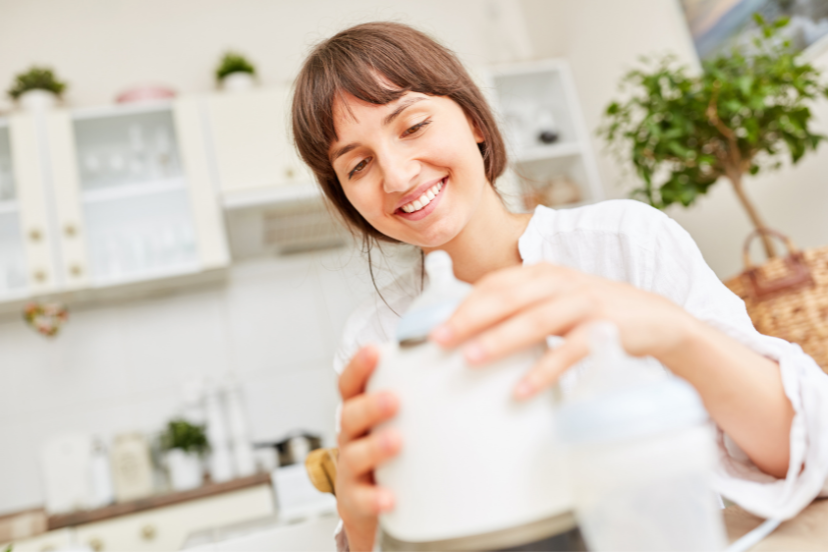How to Warm Breast Milk: A Guide for Safe Milk Heating
Are you a new parent seeking the best ways to warm breast milk for your little one? How to Warm Breast Milk is a common concern for parents who are looking to provide their babies with the optimal feeding experience. Warming breast milk requires precision and care to retain its nutritional value. In this comprehensive guide, we’ll walk you through various methods and techniques to ensure safe and efficient breast milk warming. From basic guidelines to expert tips, we’ve got you covered.
Getting Started: Why Warm Breast Milk Matters
Before diving into the specifics of how to warm breast milk, let’s explore why this step is crucial for your baby’s feeding routine.
Breast milk is a precious source of essential nutrients and antibodies that boost your baby’s immune system. However, it often needs to be warmed to a suitable temperature to make it comfortable and enjoyable for your little one. Why is Warming Breast Milk Important? When breast milk is too cold, your baby may refuse to feed or find it uncomfortable. On the other hand, overheating breast milk can lead to the loss of valuable nutrients.
How to Warm Breast Milk: The Essential Steps
Warming breast milk is more than just heating it up. It’s about maintaining its nutrient profile while making it just right for your baby. Let’s delve into the detailed steps on how to warm breast milk effectively.
1. Gather Your Supplies
Before starting the warming process, ensure you have all the necessary items at hand. You’ll need:
- A clean container or bottle with a lid
- Breast milk stored in the refrigerator or freezer
- A reliable bottle warmer, warm water, or a microwave
- A spoon or stirring stick
2. Thawing Frozen Breast Milk
If you’ve stored breast milk in the freezer, the first step is thawing it properly. How to Thaw Frozen Breast Milk involves a slow, gradual process:
- Take the frozen breast milk from the freezer and place it in the refrigerator overnight. This gradual thawing helps preserve the milk’s nutrients.
- Alternatively, you can thaw the milk by placing it under warm, running water or in a bowl of warm water. Swirl the container gently to distribute the heat evenly.
3. Using a Bottle Warmer
Bottle warmers are a safe and efficient method for warming breast milk. Here’s how to use one:
- Follow the manufacturer’s instructions for setting up the bottle warmer.
- Place the breast milk bottle in the warmer and choose the appropriate setting based on the milk’s initial temperature.
- Once warmed, shake the bottle gently to distribute the heat uniformly.
4. Warming Breast Milk with Warm Water
Warming breast milk with warm water is a traditional and safe method. Here’s a step-by-step approach:
- Fill a bowl or basin with warm water. Ensure the water is not too hot to maintain the milk’s nutrients.
- Place the breast milk container in the warm water, making sure it’s well-sealed to prevent water from entering.
- Let the breast milk sit in the warm water until it reaches the desired temperature, gently swirling the container occasionally for even heating.
5. Using a Microwave
While microwaving breast milk is possible, it requires extra caution to avoid overheating. Here’s how to do it correctly:
- Transfer the breast milk to a microwave-safe container.
- Heat the milk in short intervals, stirring between each to prevent hot spots.
- Test the milk’s temperature on your wrist before feeding it to your baby.
6. Checking the Milk’s Temperature
Always ensure the breast milk reaches a comfortable temperature for your baby. Test it by placing a few drops on the inside of your wrist. It should feel warm, not hot.
FAQs About Warming Breast Milk
1. Can I warm breast milk multiple times?
No, it’s not advisable. Repeated heating can destroy essential nutrients and increase the risk of bacterial contamination. It’s best to use the milk within 1-2 hours after warming.
2. Is it safe to use a microwave to warm breast milk?
While possible, using a microwave requires caution. Improper heating can create hot spots that can scald your baby. Opt for safer methods like warm water or a bottle warmer.
3. What temperature should breast milk be when feeding a baby?
The ideal temperature is around body temperature or about 98.6°F (37°C). Test it on your wrist to ensure it’s not too hot or too cold.
4. Can I warm breast milk on the stovetop?
It’s not recommended to warm breast milk directly on the stovetop as it can create hot spots and destroy nutrients. Stick to safer methods like warm water or bottle warmers.
5. How long can I leave warmed breast milk out at room temperature?
It’s safe to leave warmed breast milk at room temperature for up to 2 hours. After that, discard any unused milk.
6. Can I mix freshly pumped breast milk with refrigerated breast milk?
Yes, you can mix freshly pumped breast milk with refrigerated breast milk. Ensure both are at the same temperature before combining them.
In Conclusion
Learning how to warm breast milk is an essential aspect of ensuring your baby’s feeding experience is comfortable and enjoyable. Whether you opt for a bottle warmer, warm water, or a microwave, following the proper warming techniques is vital to retain the milk’s nutritional value. Remember, always prioritize your baby’s safety and nutrition when warming breast milk.




